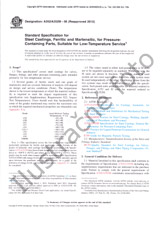Potrebujeme váš súhlas na využitie jednotlivých dát, aby sa vám okrem iného mohli ukazovať informácie týkajúce sa vašich záujmov. Súhlas udelíte kliknutím na tlačidlo „OK“.
ASTM F2808-17
Standard Test Method for Performing Behind-the-Knee (BTK) Test for Evaluating Skin Irritation Response to Products and Materials That Come Into Repeated or Extended Contact with Skin
NORMA vydaná dňa 1.11.2017
Informácie o norme:
Označenie normy: ASTM F2808-17
Poznámka: NEPLATNÁ
Dátum vydania normy: 1.11.2017
Kód tovaru: NS-800800
Počet strán: 23
Približná hmotnosť: 69 g (0.15 libier)
Krajina: Americká technická norma
Kategória: Technické normy ASTM
Kategórie - podobné normy:
Anotácia textu normy ASTM F2808-17 :
Keywords:
clinical study, human testing, mechanical and chemical skin irritation, skin friction, skin irritation,, ICS Number Code 11.100.99 (Other standards related to laboratory medicine)
Doplňujúce informácie
| Significance and Use | ||||||||
|
5.1 This test method is intended to assess a combination of inherent chemical irritation and mechanical irritation for products and materials expected to come into contact with the skin. It is a comparative approach whereby the potential irritation of a test material is compared to that of a reference material similar in form and composition. The reference material should have a known safety and irritation profile. |
||||||||
| 1. Scope | ||||||||
|
1.1 The Behind-the-Knee (BTK) method, using the popliteal fossa of human volunteers as a test site, simultaneously evaluates the inherent chemical irritation, and the potential for mechanical irritation of substrates and products that are designed to come into repeated or extended close contact with the skin (see validation references 1.2 This test method shall be used by qualified health care professionals experienced in good clinical practice (GCP) procedures. 1.3 This test method can be performed using human subjects on either intact or compromised skin. Testing should be performed on intact skin for test substrates or products expected to have contact with normal, intact skin, or for direct comparison to products with a known skin irritation profile. Testing can be performed on compromised skin for test substrates or products that may commonly come into contact with damaged skin (for example, skin with diaper rash, or chapped skin) or skin that is expected to be hydrated. 1.4 Visual scoring of erythema and dryness is performed by a trained skin grader on a pre-defined scale. 1.5 Prior to use in this test, materials shall undergo overall favorable biocompatibility testing consistent with the approach outlined in protocol Practice F748 or ISO 10993-1:2009. As a part of this series of testing, irritation per Practice F719 or ISO 10993-10 shall be conducted. 1.6 The values stated in inch-pound units are to be regarded as standard. No other units of measurement are included in this standard. 1.7 This standard does not purport to address all of the safety concerns, if any, associated with its use. It is the responsibility of the user of this standard to establish appropriate safety and health practices and determine the applicability of regulatory limitations prior to use. 1.8 This international standard was developed in accordance with internationally recognized principles on standardization established in the Decision on Principles for the Development of International Standards, Guides and Recommendations issued by the World Trade Organization Technical Barriers to Trade (TBT) Committee. |
||||||||
| 2. Referenced Documents | ||||||||
|




 Cookies
Cookies
